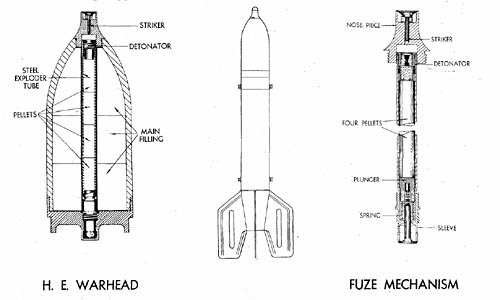
This rocket is actually 78 mm in diameter. Two features distinguish it from other German rockets: the use of tail fins to secure stability in flight without rotation, and the employment of a novel fuze arming device.
The complete round weighs 15.19 pounds and is nearly 28 inches long. Its two principal components are the nose fuzed high explosive war head and the rocket motor tube. The shell is attached by means of an adaptor ring and the motor tube is closed by a cone-shaped assembly carrying the fins and containing the venturi and propellant supporting grid. Six tubular sticks of cordite form the propellant ignited by a circular gun powder igniter set off by a wire ignition bridge. The launcher used is the Mantelrohr.
The nose fuze consists of a steel nose piece housing a light alloy striker held by a light spring, a percussion detonator, a magazine containing four pressed pellets, and a thermal arming device. When the rocket is fired, the heat of the propellant gases melts a ring of fusable metal, permitting the detonator and magazine to approach the striker. The main filling of the high explosive head is pressed flake TNT.
SPECIFICATIONS
| Weight of complete round | 15 lbs., 3 oz. | |
| Weight of motor unit with central adaptor | 10 lbs. | |
| Weight of high explosive head with central adaptor | 6 lbs., 5 oz. | |
| Weight of high explosive filling | 1 lb., 5 1/2 oz. | |
| Weight of fuze (approx.) | 4 oz. | |
| Weight of propellant sticks | 2 lbs., 3 oz. | |
| Length of rocket | 27.7 ins. | |
| Ground range (estimated) | 6,300 yds. |
German: p. 359 (May 1, 1945)
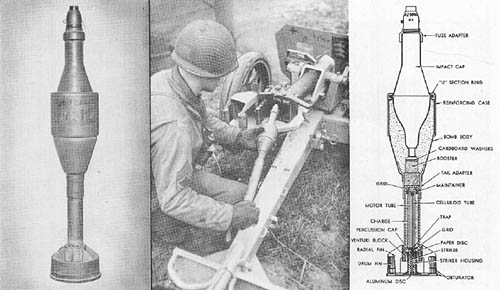
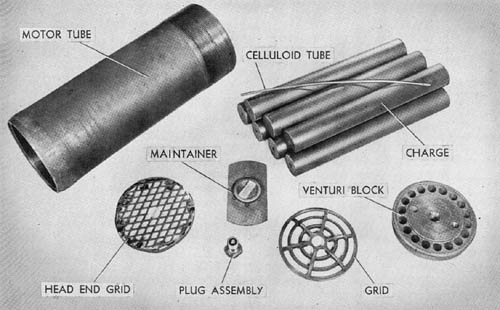
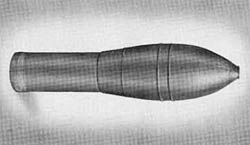
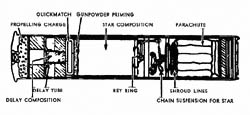 This type grenade has the same general contours as the two others previously described. It has a black bakelite head and a screwed-on base plug which is perforated to hold a gunpowder pellet. Inside the grenade, directly above the plug is an illuminating star to which a parachute is attached. On firing, the flash from the propellant ignites the gunpowder pellet, which, after a brief delay, ignites the star. The bakelite head is blown off, and the star ejected. The grenade may be identified by the stencilling “F. Leucht. Z.” on the base of the cartridge case.
This type grenade has the same general contours as the two others previously described. It has a black bakelite head and a screwed-on base plug which is perforated to hold a gunpowder pellet. Inside the grenade, directly above the plug is an illuminating star to which a parachute is attached. On firing, the flash from the propellant ignites the gunpowder pellet, which, after a brief delay, ignites the star. The bakelite head is blown off, and the star ejected. The grenade may be identified by the stencilling “F. Leucht. Z.” on the base of the cartridge case.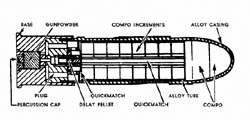 This grenade is similar in appearance and construction to the high explosive grenade except that it contains a smoke generator instead of an explosive filler. It is fitted with a percussion type nose fuze which has a charge of gunpowder located just below the flash cap instead of a detonator. The projectile functions on impact and the gunpowder, ignited by the flash cap, ejects the smoke generator from the body of the grenade and at the same time ignites it. The projectile may be recognized by the following stencilled marking on the base of the cartridge case: NEBEL. Z.
This grenade is similar in appearance and construction to the high explosive grenade except that it contains a smoke generator instead of an explosive filler. It is fitted with a percussion type nose fuze which has a charge of gunpowder located just below the flash cap instead of a detonator. The projectile functions on impact and the gunpowder, ignited by the flash cap, ejects the smoke generator from the body of the grenade and at the same time ignites it. The projectile may be recognized by the following stencilled marking on the base of the cartridge case: NEBEL. Z.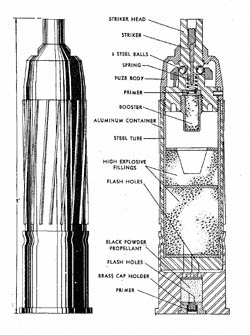 This grenade consists of a die cast aluminum container which encases a steel tube containing the explosive charge. Into the steel tube is screwed a direct action nose fuze with a protruding striker head. The striker is held away from the detonator by six steel balls kept in position by a steel collar supported on three aluminum pins. The creep spring separates the striker and primer beneath which is a booster separated from the main filling by an empty air space. The black powder propelling charge is contained in a cup with a lead Styphnate primer. The grenade has grooves on the aluminum body fitting the rifling of the Kampfpistole from which it is discharged.
This grenade consists of a die cast aluminum container which encases a steel tube containing the explosive charge. Into the steel tube is screwed a direct action nose fuze with a protruding striker head. The striker is held away from the detonator by six steel balls kept in position by a steel collar supported on three aluminum pins. The creep spring separates the striker and primer beneath which is a booster separated from the main filling by an empty air space. The black powder propelling charge is contained in a cup with a lead Styphnate primer. The grenade has grooves on the aluminum body fitting the rifling of the Kampfpistole from which it is discharged.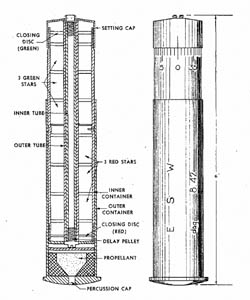 The cartridge consists of a light alloy outer container complete with the propelling charge and an inner-container in which there are six star units. Running through the center of the star units is an assembly of two brass tubes with selector holes for the six choices of settings. The inner tube contains gunpowder and is closed by a plug which contains a delay pellet. In firing, the inner container is propelled and after the delay pellet has burned through, the flash passes immediately along the whole length of the inner tube, igniting and ejecting the stars in accordance with the setting.
The cartridge consists of a light alloy outer container complete with the propelling charge and an inner-container in which there are six star units. Running through the center of the star units is an assembly of two brass tubes with selector holes for the six choices of settings. The inner tube contains gunpowder and is closed by a plug which contains a delay pellet. In firing, the inner container is propelled and after the delay pellet has burned through, the flash passes immediately along the whole length of the inner tube, igniting and ejecting the stars in accordance with the setting.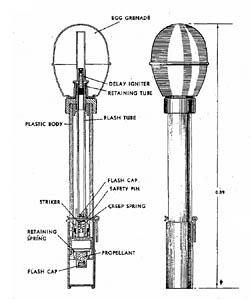 This pistol grenade is formed by adding to the egg-type hand grenade (Eierhandgranate 39) a plastic stem to which it is attached by a retaining tube. The tube contains the delay igniter at the forward end inside the grenade. An alloy flash tube connects this to the fuze which is located in the base of the stem. The fuze is separated from the primer by a safety pin which is pulled out before the grenade is placed in the pistol barrel. Upon firing, the firing pin strikes the primer which sets off the delay igniter, detonating the explosive charge after a delay of 4.5 seconds.
This pistol grenade is formed by adding to the egg-type hand grenade (Eierhandgranate 39) a plastic stem to which it is attached by a retaining tube. The tube contains the delay igniter at the forward end inside the grenade. An alloy flash tube connects this to the fuze which is located in the base of the stem. The fuze is separated from the primer by a safety pin which is pulled out before the grenade is placed in the pistol barrel. Upon firing, the firing pin strikes the primer which sets off the delay igniter, detonating the explosive charge after a delay of 4.5 seconds.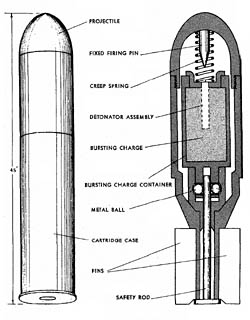 This grenade, consisting of a rounded nose cap screwed to a cylindrical body, is equipped with four fins which are fixed to the base of the body. A brass or aluminum cartridge crimped to the grenade completes the assembly. A case containing the detonator and main filling is separated from a fixed firing pin in the nose of the grenade by a creep spring. The case is prevented from moving forward before firing by two metal balls in the base of the carrier. An arming rod inserted between the two balls prevents them from moving. This is forced out of the base by setback about ten or twelve yards after the grenade leaves the muzzle of the gun. The balls then slide out of their grooves and the case is free to move against the firing pin, exploding the grenade on impact.
This grenade, consisting of a rounded nose cap screwed to a cylindrical body, is equipped with four fins which are fixed to the base of the body. A brass or aluminum cartridge crimped to the grenade completes the assembly. A case containing the detonator and main filling is separated from a fixed firing pin in the nose of the grenade by a creep spring. The case is prevented from moving forward before firing by two metal balls in the base of the carrier. An arming rod inserted between the two balls prevents them from moving. This is forced out of the base by setback about ten or twelve yards after the grenade leaves the muzzle of the gun. The balls then slide out of their grooves and the case is free to move against the firing pin, exploding the grenade on impact.